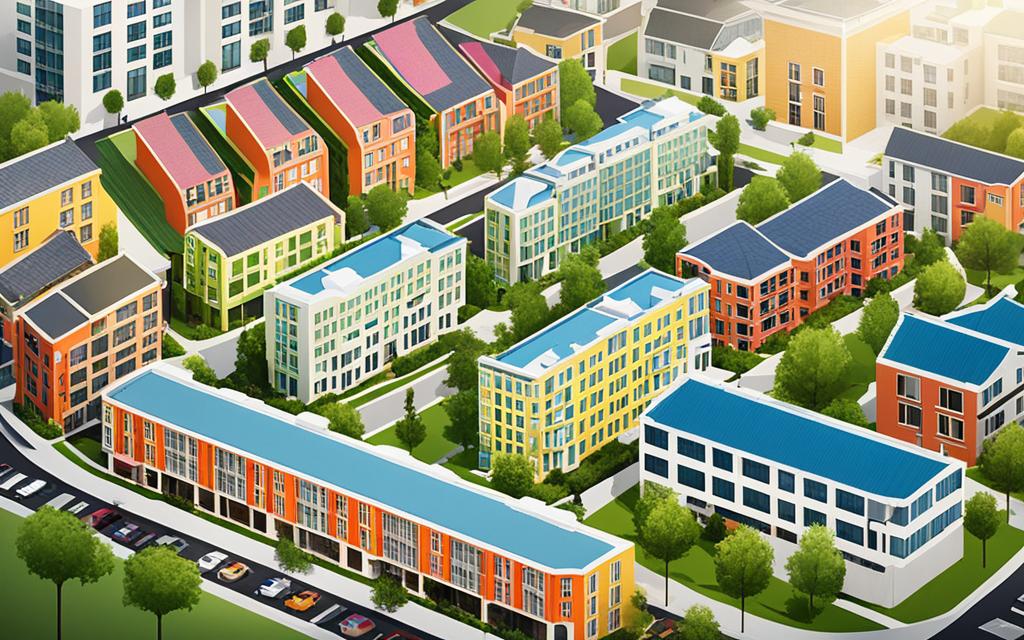Have you ever found yourself daydreaming about living in a charming cottage nestled by the countryside, or perhaps in a sleek apartment overlooking the bustling city skyline? The concept of home is deeply intertwined with our emotions and aspirations. It’s a place where we seek solace, make cherished memories, and find a sense of belonging. But have you ever wondered how different countries address their housing needs and shape their residential landscapes?
Today, we embark on an enlightening journey to explore international housing systems and unveil the latest trends that shape the global residential market. From Australia’s high rate of homeownership to Germany’s rental culture, each country has its unique approach to housing. By understanding these diverse systems, we can gain valuable insights into the challenges and solutions that shape the places we call home.
Key Takeaways
- International housing systems vary greatly, each with its own set of policies and approaches.
- Trends in the global residential market influence housing choices and affordability.
- Australia emphasizes homeownership, while Germany embraces a rental-oriented housing system.
- Austria excels in social housing, providing affordable options for its residents.
- India faces unique challenges in meeting its growing housing demand and seeks innovative solutions.
The Australian Housing System
Australia has a unique housing system that sets it apart on the global stage. With a high rate of homeownership and a strong emphasis on detached houses, the Australian housing market offers a distinct landscape for residents and investors alike.
Key Features of the Australian Housing Market
When exploring the Australian housing system, several key features come to the forefront. These include government initiatives, housing affordability, and recent trends that shape the current state of housing in the country.
Government Initiatives
The Australian government plays a crucial role in supporting and regulating the housing market. Policies and initiatives focus on stimulating homeownership, improving housing affordability, and promoting sustainable development. Programs such as the First Home Loan Deposit Scheme and the National Rental Affordability Scheme aim to assist first-time buyers and those in need of affordable rental accommodation.
Housing Affordability
Housing affordability is a significant consideration in the Australian market. The cost of housing varies across different regions, with major cities like Sydney and Melbourne experiencing higher prices compared to regional areas. Factors such as supply and demand dynamics, wage growth, and interest rates influence affordability levels.
Impact of Recent Trends
The Australian housing system is not static, with recent trends reshaping the landscape. One notable trend is the increasing popularity of apartment living, particularly in urban areas. This shift reflects changing lifestyle preferences and the need for more compact and centrally located housing options.
Additionally, sustainable and eco-friendly housing features prominently in contemporary developments. Green building practices, energy-efficient designs, and the use of renewable resources contribute to a more sustainable and environmentally conscious housing sector.
To gain a clearer understanding of the Australian housing system, let’s take a closer look at some key statistics:
| Statistic | Value |
|---|---|
| Homeownership Rate | 67% |
| Average House Price | £700,000 |
| New Dwelling Starts | 250,000 per year |
| Investor Activity | 30% of residential property market |
These figures provide valuable insights into the Australian housing system, demonstrating the country’s strong homeownership culture and the significant presence of investors in the property market.
The Austrian Housing System
Austria’s housing market is known for its robust regulations and social housing initiatives. The country has put in place comprehensive policies and tenancy laws to ensure affordable and accessible housing for its citizens. Social organizations play a crucial role in augmenting these efforts and providing additional affordable housing options. Let’s explore the key aspects of the Austrian housing system.
Housing Policies in Austria
Austria prioritizes housing affordability and stability through a range of policies. The government promotes social housing developments and encourages the construction of affordable homes. These policies aim to ensure that a significant portion of the population has access to secure housing options.
Tenancy Laws
Clear and balanced tenancy laws in Austria protect the rights of both tenants and landlords. These laws establish guidelines for rent increases, lease agreements, and dispute resolution. The goal is to maintain a harmonious relationship between tenants and landlords while safeguarding tenants’ interests.
Social Organizations and Affordable Housing
Social organizations play a vital role in meeting the growing demand for affordable housing in Austria. They actively collaborate with the government to develop and manage social housing projects. These organizations provide affordable rental options and support vulnerable groups in accessing suitable accommodation.
The Austrian housing system showcases a successful blend of governmental regulations and the contribution of social organizations. This ensures that individuals and families across the country have access to affordable and secure housing options. By prioritizing affordability and stability, Austria sets an example for other nations to follow in addressing housing challenges.
The Belgian Housing System
Belgium offers a diverse housing landscape, accommodating both rental and homeownership options. In this section, we will delve into the intricate details of the Belgian housing market, exploring the role of cooperative housing and innovative urban planning strategies.
Belgium’s housing system reflects the country’s commitment to providing a range of housing solutions that cater to the needs of its population. With a mix of rental properties and homeownership opportunities, Belgium promotes a balanced approach to housing.
One key element of the Belgian housing system is the presence of cooperative housing. Cooperative housing associations play a crucial role in providing affordable and sustainable homes for residents. These associations allow individuals to collectively own and manage their housing, ensuring democratic decision-making and fostering a strong sense of community.
The Role of Cooperative Housing
Cooperative housing initiatives have gained significant traction in Belgium, allowing residents to actively participate in the management and maintenance of their homes. These initiatives prioritize affordability and sustainability, making them an attractive option for individuals seeking secure and community-centered housing solutions.
Cooperative housing associations in Belgium contribute to addressing the housing needs of various demographics, including families, senior citizens, and low-income individuals. By pooling resources and sharing responsibilities, residents can enjoy well-maintained properties at reasonable costs.
Furthermore, cooperative housing promotes inclusive communities and encourages social interaction through shared spaces and collaborative decision-making processes. It fosters a sense of belonging and cooperation among residents, creating vibrant and supportive neighborhoods.
Innovative Urban Planning Strategies
In addition to cooperative housing, Belgium also embraces innovative urban planning strategies to enhance the quality of its housing system. The country prioritizes sustainable development, aiming to create livable and environmentally friendly neighborhoods.
Urban planning initiatives in Belgium focus on integrating residential areas with essential amenities such as schools, healthcare facilities, and public transportation. This approach promotes accessibility and convenience for residents, ensuring they have easy access to necessary services and reducing reliance on private transportation.
Moreover, sustainable building practices are central to Belgium’s housing system. The country prioritizes energy-efficient construction, incorporating technologies and materials that minimize environmental impact and reduce energy consumption. This commitment to sustainability contributes to creating greener communities and ensuring long-term housing affordability and comfort.
By prioritizing cooperative housing and implementing innovative urban planning strategies, Belgium’s housing system strives to provide inclusive, sustainable, and community-focused solutions to its residents.
The Canadian Housing System
Canada’s housing system is a reflection of the country’s vast landscape and cultural diversity. Across Canada, various housing models cater to the diverse needs and preferences of its residents. However, affordability remains a significant challenge in many parts of the country, particularly in urban centers. In this section, we will explore the Canadian housing system, discuss the affordability issues faced by Canadians, and analyze recent trends that are shaping the housing market.
Housing Models Across Canada
The Canadian housing market encompasses a range of housing models, including detached houses, condominiums, townhouses, and rental apartments. These different housing types cater to individuals and families with distinct lifestyle and financial requirements. While detached houses have traditionally been popular in suburban areas, there has been a rise in the demand for urban living and mixed-use developments, leading to the construction of more condominiums and townhouses in city centers.
Affordability Challenges
One of the key issues in the Canadian housing system is affordability. High housing prices and increasing rental costs have made it difficult for many Canadians, especially young adults and low-income households, to access affordable housing. This has led to concerns about housing affordability, particularly in major cities like Vancouver and Toronto. The Canadian government has implemented various initiatives and programs to address this issue, such as the National Housing Strategy and the First-Time Home Buyer Incentive.
Recent Trends: Co-living Spaces
In recent years, there has been a growing trend of co-living spaces in Canada. Co-living offers an alternative housing option for individuals who value community, convenience, and affordability. These spaces typically consist of private bedrooms and shared common areas, allowing residents to enjoy the benefits of communal living while maintaining their privacy. Co-living spaces have gained popularity among young professionals, students, and individuals seeking a more affordable housing option in urban areas.
Overall, the Canadian housing system is a dynamic mix of housing models that cater to the diverse needs of its residents. While housing affordability remains a challenge, the Canadian government and various stakeholders are working towards creating more accessible and sustainable housing solutions. The rise of co-living spaces demonstrates the evolving preferences and demands of Canadians in the pursuit of affordable housing options.
The Czech Republic Housing System
The Czech Republic’s housing system has undergone significant transformations since the fall of communism, shifting from a centrally planned system to a market-oriented approach. This transition has brought about new challenges in terms of housing availability and affordability.
Following the collapse of communism in 1989, the Czech Republic began implementing housing reforms to transition from a state-controlled system to a more market-driven one. Privatization efforts sought to transfer state-owned properties to individuals and encourage the development of a private real estate market.
Today, the Czech Republic’s housing market is characterized by a mix of rental and homeownership options. While many individuals own their homes, rental properties also play a significant role, especially in major cities like Prague and Brno.
Housing availability and affordability remain key challenges in the Czech Republic. The rising demand for housing, particularly in urban areas, has led to an increase in property prices and rental rates. This has posed difficulties for low-income individuals and young professionals seeking affordable housing options.
Additionally, the Czech Republic faces issues related to housing quality and energy efficiency. Many older buildings require renovation and modernization to meet contemporary standards. Efforts are being made to address these challenges through urban revitalization projects and initiatives promoting sustainable and energy-efficient housing.
Government Initiatives
The Czech government has implemented various initiatives to address housing issues and promote affordability. One notable program is the State Housing Development Fund, which provides financial assistance and subsidies for housing construction and renovation projects. The fund aims to increase the availability of affordable housing options, particularly for low-income individuals and vulnerable populations.
Furthermore, the government has introduced legislation to regulate the rental market and protect tenants’ rights. These measures include rent control policies and regulations regarding eviction procedures to ensure fair and stable housing conditions for renters.
Housing Associations and Non-profit Organizations
Housing associations and non-profit organizations also play a significant role in the Czech housing system. These entities focus on providing social and affordable housing options, particularly for individuals with lower incomes and special needs. They often collaborate with the government and private sector to develop housing projects and support vulnerable populations.
Overall, the Czech Republic’s housing system reflects the country’s transition from a centrally planned economy to a market-driven one. While progress has been made in improving housing availability and affordability, challenges remain. Continued efforts by the government, housing associations, and non-profit organizations are crucial to addressing these challenges and ensuring a sustainable and inclusive housing market.
The French Housing System
In France, the housing market offers a diverse range of options to accommodate different needs and preferences. One of the key aspects of the French housing system is the strong emphasis on social housing, ensuring that affordable homes are available to those in need.
Rent controls play a significant role in regulating the rental market, ensuring that tenants are protected from excessive rent increases. These controls aim to maintain stability and affordability in the housing sector, benefiting both tenants and landlords.
Tenant protection laws in France aim to provide security and ensure fair treatment for renters. These laws outline the rights and responsibilities of both tenants and landlords, establishing a balanced and transparent relationship between the two parties.
The French government is also actively involved in promoting affordable housing through various subsidized programs. These programs aim to support individuals and families with limited financial resources by providing financial aid and incentives for housing. They play a crucial role in addressing housing affordability challenges in the country.
The German Housing System
In Germany, the housing system is unique due to its strong emphasis on rentals and the presence of housing cooperatives. Understanding the German approach to housing can provide valuable insights into sustainable and affordable housing practices.
The concept of a “rental culture” is deeply ingrained in German society, with a significant proportion of the population choosing to rent rather than buy homes. This preference for renting is supported by a well-regulated rental market that provides tenants with robust legal protection and rent stability.
Housing cooperatives also play a prominent role in the German housing system. These cooperative organizations are formed by residents who jointly own and manage properties, ensuring affordable housing options and fostering a sense of community among residents.
In recent years, Germany has witnessed the emergence of micro-apartments as a response to the increasing demand for affordable housing in urban areas. These small but efficiently designed living spaces cater to single occupants or young professionals, offering cost-effective and sustainable housing solutions.
Sustainability is a key focus of the German housing system, with a strong emphasis on energy efficiency and environmentally friendly construction practices. The country’s commitment to sustainable housing is reflected in the proliferation of energy-efficient buildings and the promotion of renewable energy sources.
Let’s delve into the key features of the German housing system in the following table:
| Key Features of the German Housing System |
|---|
| Rental Culture |
| Housing Cooperatives |
| Micro-Apartments |
| Sustainable Housing |
The Indian Housing System
India faces unique challenges in meeting the housing needs of its growing population. With a diverse housing landscape, ranging from informal settlements to government-sponsored affordable housing schemes, the Indian housing system requires innovative solutions to address the housing deficit.
Informal Settlements
One of the prominent features of the Indian housing system is the presence of informal settlements, commonly referred to as slums. These settlements are characterized by inadequate infrastructure, limited access to basic amenities, and insecure tenure. Slum rehabilitation programs aim to improve the living conditions of residents by providing alternative housing options and upgrading infrastructure.
Affordable Housing Schemes
The Indian government has launched several affordable housing schemes to cater to the needs of low-income households. These schemes offer subsidized housing options and aim to increase homeownership among the economically weaker sections of society. Examples include the Pradhan Mantri Awas Yojana (PMAY) and the Rajiv Awas Yojana (RAY).
Smart Cities Mission
As part of the Smart Cities Mission, the Indian government is developing smart cities across the country. These cities are designed to provide sustainable and livable housing options, incorporating modern infrastructure, efficient transportation systems, and access to digital services. The mission aims to improve the quality of life for urban residents and promote inclusive growth.
Public-Private Partnerships
Public-private partnerships (PPP) play a crucial role in addressing the housing needs in India. The collaboration between government entities and private developers helps facilitate the construction of affordable housing projects. These partnerships ensure the efficient utilization of resources and expertise to provide housing solutions that are both affordable and of good quality.
In conclusion, the Indian housing system encompasses a diverse range of housing options and challenges. From addressing informal settlements and implementing affordable housing schemes to developing smart cities and fostering public-private partnerships, India is striving to meet the housing needs of its population. By embracing innovative solutions, the Indian housing system can evolve to provide safe, affordable, and sustainable housing for all.
The Irish Housing System
Ireland has experienced significant changes in its housing system in recent years, with a renewed focus on increasing homeownership rates and enhancing housing standards. These changes have been driven by a combination of government policies, the active involvement of housing associations, and the ongoing challenges faced by the Irish housing market.
Government policies play a crucial role in shaping the Irish housing system. Initiatives such as the Rebuilding Ireland program aim to address the housing crisis by increasing the supply of affordable homes, improving the rental sector, and providing support for first-time buyers. These policies are designed to create a more inclusive and sustainable housing market.
Housing associations, also known as housing cooperatives or social housing providers, play a vital role in meeting the diverse housing needs of the Irish population. They work closely with the government to develop and manage social and affordable housing projects. These associations offer a range of housing options, including rental accommodation and shared ownership schemes, to ensure that everyone has access to safe and affordable homes.
The Role of Housing Associations
Housing associations in Ireland work tirelessly to provide quality housing for individuals and families in need. They collaborate with local authorities and other stakeholders to develop innovative housing solutions, such as mixed-tenure developments and energy-efficient homes, that cater to the specific needs of different communities.
By addressing the demand for social and affordable housing, housing associations contribute to the overall stability and sustainability of the Irish housing system. They play a crucial role in meeting the housing needs of vulnerable groups, including low-income households, the elderly, and individuals with disabilities.
However, despite these efforts, the Irish housing market still faces significant challenges. The demand for housing continues to outstrip supply, leading to rising property prices and rental costs. This affordability issue, coupled with a shortage of social and affordable housing, poses challenges for individuals and families looking for suitable homes.
The Challenges Facing the Irish Housing Market
The Irish housing market is grappling with a range of challenges, including:
- Insufficient housing supply to meet the growing demand
- Slow construction rates and a lack of affordable housing options
- High property prices and rental costs
- Homelessness and the need for emergency accommodation
These challenges highlight the urgent need for continued efforts to address the housing crisis in Ireland. By prioritizing the development of affordable housing, streamlining planning processes, and further supporting housing associations, the Irish government and relevant stakeholders can work towards creating a more sustainable and inclusive housing system.
The image above visually represents the Irish housing system, showcasing the diverse range of housing options and the pressing need for affordable homes in Ireland.
The Italian Housing System
Italy’s housing market is a unique blend of homeownership and rental options, with distinct variations in housing characteristics across different regions. Understanding the Italian housing system is crucial for anyone looking to explore residential opportunities in the country.
One prominent aspect of the Italian housing system is the role of cooperative housing. Cooperatives, known as “cooperative edilizie,” play a significant part in providing affordable housing to the Italian population. These cooperative housing projects are initiated and managed by groups of individuals who collectively own and govern their residential buildings, ensuring long-term affordability and community engagement.
Moreover, Italy has seen a rise in urban regeneration projects aimed at revitalizing neglected neighborhoods and historical city centers. These initiatives, known as “recupero edilizio,” focus on transforming underutilized or abandoned buildings into livable spaces, promoting sustainable urban development and preserving cultural heritage. Urban regeneration projects have contributed to the revival of neighborhoods and stimulated economic growth in various Italian cities.
The impact of tourism on the Italian housing market cannot be overlooked. Popular tourist destinations such as Rome, Florence, and Venice face unique challenges in housing availability due to the surge in short-term rentals and vacation homes. The demand from tourists has led to higher housing prices and limited options for locals, especially in city centers. Balancing the needs of tourists and residents remains a challenge for policymakers and urban planners.
To provide a comprehensive overview of the Italian housing system, let’s examine the homeownership rates, rental market trends, and housing affordability across different regions:
| Region | Homeownership Rate | Rental Market | Housing Affordability |
|---|---|---|---|
| Abruzzo | 67% | 33% | 3.5/10 |
| Lombardy | 46% | 54% | 5/10 |
| Tuscany | 52% | 48% | 4/10 |
| Sicily | 63% | 37% | 2/10 |
These figures highlight the variations in homeownership rates, rental market ratios, and housing affordability across different regions of Italy. It is essential to consider regional differences when analyzing the Italian housing system and making informed decisions about residential investments.
Key Takeaways:
- The Italian housing system encompasses a mix of homeownership and rental markets.
- Cooperative housing projects provide affordable residential options and foster community engagement.
- Urban regeneration initiatives revive neglected neighborhoods and contribute to sustainable urban development.
- The impact of tourism on the housing market poses challenges for housing availability and affordability.
By understanding the intricacies of the Italian housing system, individuals can navigate the diverse residential landscape and make informed decisions regarding homeownership, rental investments, and urban development opportunities.
The Japanese Housing System
Japan’s housing system is renowned for its compact living spaces and innovative architectural designs. The unique features of the Japanese housing market provide fascinating insights into the country’s approach to residential living.
Capsule and Tower Apartments
One distinctive concept in the Japanese housing system is the “capsule” and “tower” apartments. Capsule apartments, also known as “pod hotels,” offer compact living arrangements that maximize space efficiency. These self-contained units provide basic amenities and are typically rented on a short-term basis, catering to budget-conscious travelers or individuals seeking temporary accommodation.
Tower apartments, on the other hand, are multi-story residential buildings with a variety of unit sizes and layouts. These high-rise structures often feature advanced architectural designs and incorporate modern amenities and facilities. Tower apartments reflect the vertical nature of urban living in Japan, where space is limited, and the efficient use of land is essential.
Housing Affordability Challenges
Housing affordability is a significant challenge in the Japanese housing system. The cost of land and construction materials, coupled with limited available space, contributes to higher property prices. As a result, many Japanese people face difficulties in purchasing homes, particularly in major cities like Tokyo.
Additionally, the unique practice of high property depreciation in Japan further impacts affordability. It is common for buildings to depreciate over time, which can discourage long-term investments in residential properties.
Lifetime Housing
In Japan, the concept of “lifetime housing” is highly valued. Lifetime housing refers to homes that are designed to accommodate residents throughout different stages of their lives, including elderly individuals and individuals with disabilities. These residences often incorporate features such as barrier-free designs, adjustable floor plans, and technological aids to enhance accessibility and ensure comfortable living.
By prioritizing the concept of lifetime housing, Japan emphasizes the importance of creating inclusive and adaptable living environments that can cater to diverse needs and support aging populations.
Conclusion
Throughout this article, we have explored the housing systems and trends of various countries, shedding light on the diverse approaches to housing around the world. From Australia’s preference for spacious detached houses to Japan’s innovative compact living spaces, each country has its own set of housing challenges and solutions.
By examining international housing systems, we gain valuable insights into addressing housing issues and promoting sustainable practices. Understanding the intricacies of different housing markets helps us identify successful strategies and apply them to our own communities.
Whether it’s the well-regulated social housing in Austria or the rental-oriented housing system in Germany, each country offers valuable lessons in creating inclusive, affordable, and resilient housing options. By learning from these global experiences, we can work towards building better housing systems that meet the needs of our diverse populations.
As we continue to navigate the challenges of housing shortages, affordability concerns, and changing demographics, it is essential to look beyond our borders for inspiration and innovation. By embracing the strengths and addressing the weaknesses of various housing systems, we can collectively create a brighter future for housing worldwide.
FAQ
Q: What is the purpose of this article?
A: The purpose of this article is to explore international housing systems and trends, providing valuable insights into different countries’ approaches to housing and the current state of the global residential market.
Q: What is the Australian housing system like?
A: The Australian housing system is characterized by a high rate of homeownership and a strong emphasis on detached houses. We will examine key features such as government initiatives, housing affordability, and the impact of recent trends in Australia’s housing market.
Q: How does the Austrian housing system differ from others?
A: Austria boasts a well-regulated housing market with a significant focus on social housing. We will discuss the country’s housing policies, tenancy laws, and the contribution of social organizations in providing affordable housing options.
Q: What can you tell me about the Belgian housing system?
A: Belgium showcases a diverse housing landscape, with a mix of rental and homeownership options. We will delve into the intricate details of the Belgian housing market, including the role of cooperative housing and innovative urban planning strategies.
Q: How does the Canadian housing system reflect the country’s diversity?
A: Canada’s housing system reflects its vast landscape and cultural diversity. We will examine the various housing models found across Canada, discuss affordability challenges, and analyze recent trends such as the growth of co-living spaces.
Q: How has the housing system in the Czech Republic evolved?
A: The Czech Republic has experienced significant transformations in its housing system since the fall of communism. We will explore the transition from a centrally planned system to a market-oriented approach, as well as current challenges regarding housing availability and affordability.
Q: What are the key features of the French housing system?
A: France offers a comprehensive range of housing options, with a strong emphasis on social housing. We will delve into the intricacies of the French housing market, including rent controls, tenant protection laws, and government-subsidized housing programs.
Q: How does the German housing system differ from others?
A: Germany has a unique rental-oriented housing system, with a strong presence of housing cooperatives. We will examine the German approach to housing, explore the concept of “rental culture,” and analyze recent trends such as micro-apartments and sustainable housing.
Q: What are some challenges faced by the Indian housing system?
A: India faces unique challenges in meeting the housing needs of its growing population. We will discuss the diverse housing landscape in India, from informal settlements to government-sponsored affordable housing schemes, and explore innovative solutions to address the housing deficit.
Q: How has the Irish housing system changed in recent years?
A: Ireland has undergone significant changes in its housing system, with a focus on increasing homeownership and improving housing standards. We will analyze the impact of government policies, the role of housing associations, and the challenges facing the Irish housing market.
Q: What is the housing system like in Italy?
A: Italy exhibits a mix of homeownership and rental markets, with regional variations in housing characteristics. We will explore the Italian housing landscape, including the role of cooperative housing, urban regeneration projects, and the impact of tourism on housing availability.
Q: What are some unique features of the Japanese housing system?
A: Japan’s housing system is known for its compact living spaces and innovative architectural designs. We will delve into the unique features of the Japanese housing market, including the concept of “capsule” and “tower” apartments, housing affordability challenges, and the concept of “lifetime housing.”











